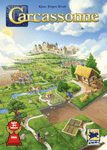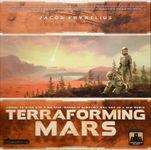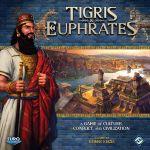
Carcassonne
Carcassonne is a tile-laying game where players take turns placing tiles to build a medieval landscape. They also place meeples to claim cities, roads, farms, and monasteries for points. The player with the most points at the end of the game wins.
How Complex is Carcassonne?
Carcassonne is easy to understand and play, with simple rules and mechanics that can be learned quickly by players of all ages and skill levels.
How much Luck is involved in the gameplay of Carcassonne?
Luck plays a moderate role in Carcassonne as players draw tiles randomly, but strategic tile placement and meeple placement can mitigate the impact of luck.
How much Player Interaction does Carcassonne offer?
Carcassonne offers moderate player interaction as players can block each other's meeple placements and compete for control of cities, roads, and farms, but there is no direct player conflict.
How much Replayability does Carcassonne offer?
Carcassonne offers high replayability due to the random tile placement and the different strategies players can use to claim points, making each game unique and challenging.
Why you should play Carcassonne
Easy to Learn
Carcassonne is a simple game to learn and play, making it perfect for beginners and experienced players alike.
Strategic Gameplay
The game requires strategic thinking and planning, as players must decide where to place their tiles and how to best use their meeples to score points.
Replayability
With different tile combinations and strategies to try out, Carcassonne offers endless replayability and keeps the game fresh and exciting.
Social Interaction
The game encourages social interaction and friendly competition, making it a great choice for game nights with friends and family.
Why you should avoid Carcassonne
Luck-Based
While the game requires strategic thinking, luck also plays a significant role in the game, as players draw tiles randomly.
Limited Player Interaction
The game can be played with up to 5 players, but the interaction between players is limited, as players are primarily focused on building their own structures and scoring points.
Slow-Paced
The game can be slow-paced, especially with more players, as each player takes turns placing tiles and meeples, which can lead to longer game sessions.
Where to play Carcassonne online?
- Board Game Arena - https://boardgamearena.com/gamepanel?game=carcassonne
- Asmodee digital - https://www.asmodee-digital.com/en/carcassonne/
Where to find the Rules of Carcassonne
Check the rules of Carcassonne in a PDF file.
You can also find the community-driven rules summary, player aid, etc., in the Carcassonne files section on the BoardGameGeek website. You need an account on BGG to download files.
Beginner Strategies for Carcassonne
These strategies are for players who have either not played or played one or two games of Carcassonne.
Start with simple tile placements
As a new player, it's best to start with simple tile placements. Place tiles in a way that allows you to complete roads or cities easily.
Focus on completing features
Completing features like roads, cities, and cloisters will earn you points. Try to complete as many features as possible to score more points.
Use your meeples wisely
Meeples are limited, so use them wisely. Place them on features that you can complete easily and that will earn you points.
Plan ahead
Try to plan ahead and anticipate where your opponents might place their tiles. This can help you position your tiles in a way that will benefit you the most.
Don't be afraid to take risks
Sometimes taking risks can pay off. For example, placing a tile that connects two incomplete features can earn you points for both features.
Keep track of the scoring
Keep track of the scoring throughout the game to see where you stand compared to your opponents. This can help you adjust your strategy as needed.
Overall, Carcassonne is a game that requires a mix of strategy and luck. By following these tips, you can increase your chances of winning and have a fun time playing the game.
Advanced Strategies for Carcassonne
Be flexible with your strategy
As you become more familiar with the game, you'll start to develop your own strategies. However, it's important to be flexible and adapt your strategy based on the tiles that are available and the moves your opponents are making.
Use the farmer meeple strategically
The farmer meeple can be a powerful tool if used correctly. Try to place them on fields that are adjacent to multiple cities or roads, as this can earn you a lot of points at the end of the game.
Take advantage of the scoring opportunities
There are 4 different ways to score points in Carcassonne, so try to take advantage of as many scoring opportunities as possible.
Block your opponents' moves
Blocking your opponents' moves can be a great way to gain an advantage. Try to place tiles in a way that prevents your opponents from completing their features or earning points.
Keep track of the tiles
As you play more games, you'll start to recognize the different tiles and their potential uses. Keep track of the tiles that have already been played and try to anticipate which tiles might be coming up next.
Don't forget about the cloisters
Cloisters can be an easy way to earn points, especially if you place them in a corner where they can't be easily blocked. Don't forget to keep an eye out for opportunities to place cloisters.
Plan for the endgame
The endgame can be the most important part of the game, as it's when the majority of the points are scored. Try to plan ahead and position your meeples in a way that will earn you the most points at the end of the game.
Overall, the key to success in Carcassonne is to be flexible, adaptable, and strategic. By following these tips, you can increase your chances of winning and have a fun time playing the game.






